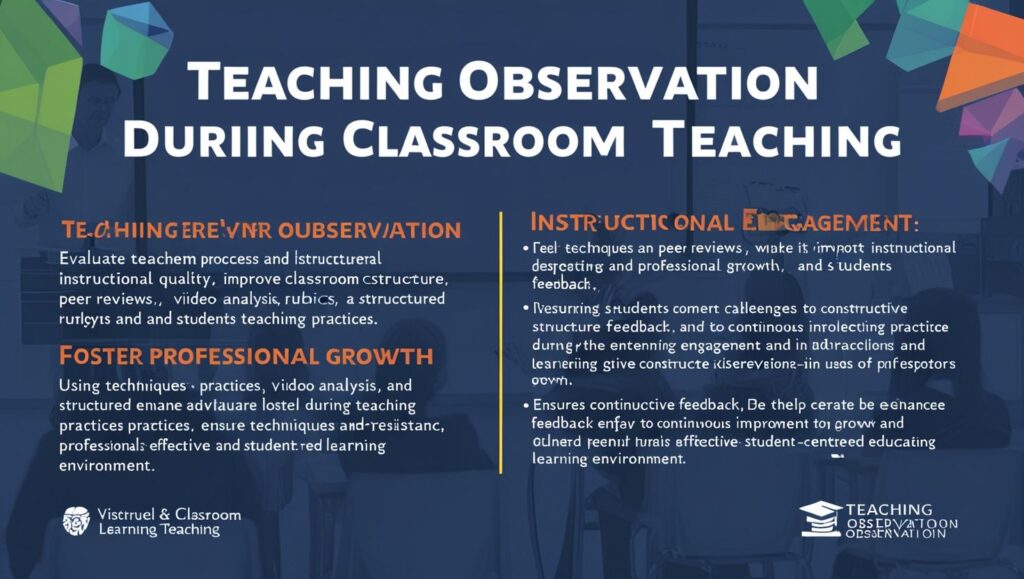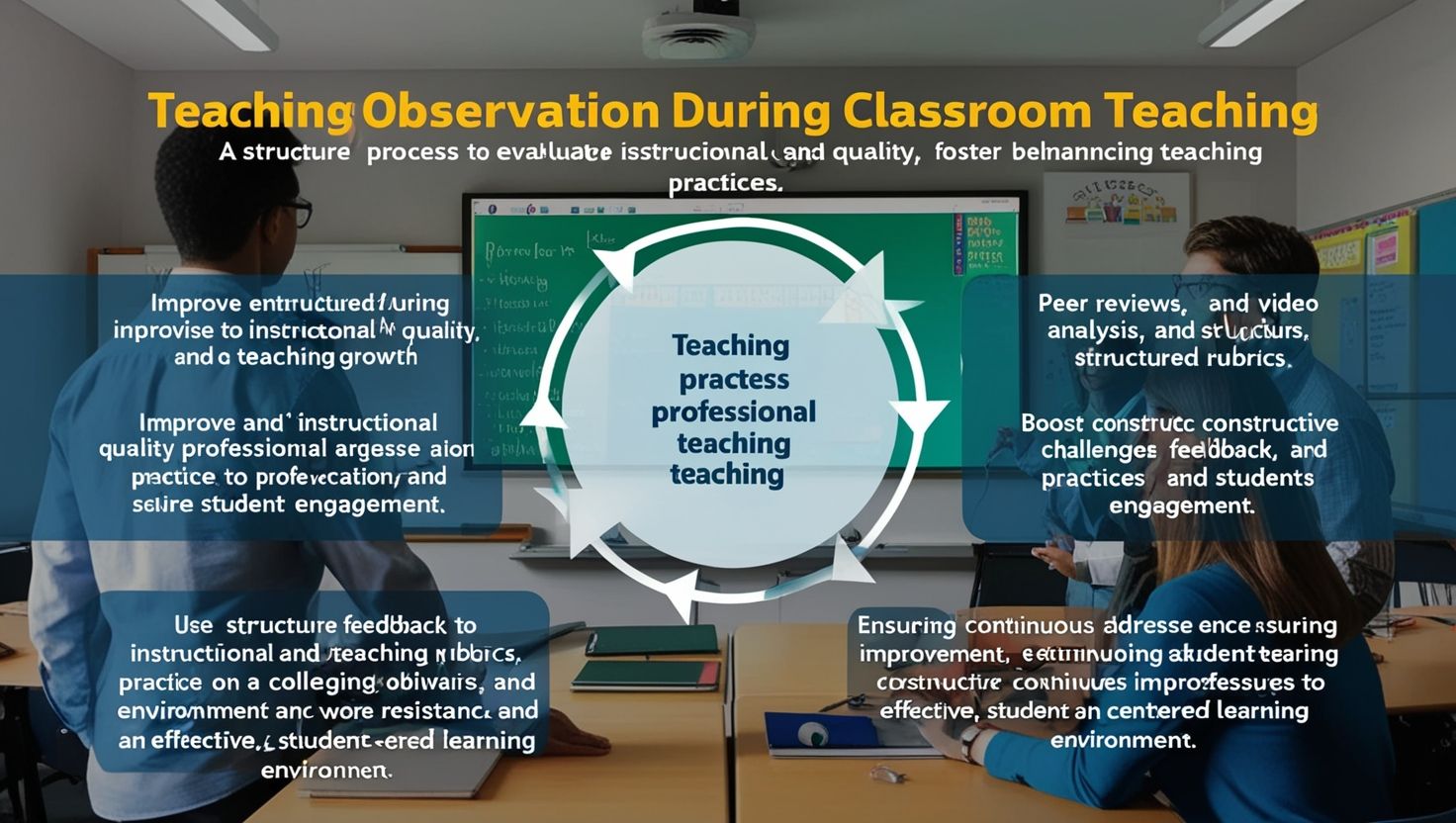Introduction
Teaching Observation During Classroom Teaching, Teaching observation plays a pivotal role in enhancing the quality of education. It provides a mechanism for evaluating and improving teaching practices, ensuring that educators deliver content effectively and engage students in meaningful learning. In classroom settings, observations serve as an essential feedback tool for teachers and administrators to reflect, analyze, and grow professionally.
This article explores the concept of teaching observation, its objectives, techniques, and the impact on both educators and students. Additionally, it discusses strategies to conduct effective observations and address challenges, supported by six credible references.
The Significance of Teaching Observation
Teaching observation is the systematic process of assessing and analyzing teaching methods, classroom management, and student engagement. Its importance lies in:
- Quality Assurance: Ensures that teaching meets institutional and pedagogical standards.
- Professional Development: Provides constructive feedback for teachers to refine their skills.
- Student-Centric Focus: Enhances learning by identifying gaps in teaching strategies.
- Data-Driven Insights: Facilitates research into effective educational practices.
Regular observations help align teaching practices with educational goals, fostering a culture of continuous improvement.
Objectives of Classroom Observations
- Evaluation: To measure the effectiveness of teaching strategies and curriculum delivery.
- Support: To assist educators in developing innovative and engaging methods.
- Reflection: To enable teachers to assess their practices objectively.
- Accountability: To ensure adherence to institutional policies and standards.
- Research: To gather data for academic studies on pedagogical methodologies.
These objectives ensure that the observation process is purposeful and aligned with the broader goals of education.
Techniques of Teaching Observation
Classroom observation involves various techniques tailored to specific objectives:
- Peer Observation: Teachers observe each other’s lessons to share insights and strategies.
- Administrator Observation: School leaders evaluate teachers for performance appraisals.
- Self-Observation: Teachers record their lessons for self-review and improvement.
- Video Recording: Allows for detailed analysis of teaching practices and student behavior.
- Structured Observation: Uses checklists and rubrics to evaluate specific criteria, such as clarity, pacing, and student interaction.
The choice of technique depends on the desired outcomes and context of the observation.
Effective Practices for Teaching Observation
- Pre-Observation Planning:
- Define objectives and key areas of focus.
- Discuss the lesson plan and goals with the teacher being observed.
- Non-Intrusive Observation:
- Minimize disruption to the class by maintaining a low profile.
- Avoid engaging with students or interrupting the teacher.
- Documentation:
- Use observation tools, such as rubrics or note-taking templates, to record observations systematically.
- Post-Observation Feedback:
- Provide constructive, actionable feedback.
- Focus on strengths while addressing areas for improvement.
- Follow-Up:
- Encourage teachers to implement recommendations.
- Schedule subsequent observations to track progress.
These practices foster a collaborative and supportive environment for professional growth.
Impact of Teaching Observation
- On Teachers:
- Enhanced Self-Awareness: Observations help teachers recognize their strengths and areas for improvement.
- Skill Development: Exposure to different teaching styles inspires innovation and creativity.
- Increased Confidence: Positive feedback reinforces effective practices.
- On Students:
- Improved Learning Outcomes: Effective teaching practices lead to better understanding and retention.
- Engagement: Teachers adopt methods that resonate with students, fostering active participation.
- On Institutions:
- Standardization: Ensures consistency in teaching quality across classrooms.
- Culture of Excellence: Promotes a commitment to continuous improvement.
By addressing these facets, teaching observation becomes a transformative tool for education.

Challenges in Classroom Observations
- Bias:
Observers may bring subjective judgments, impacting the fairness of evaluations. - Resistance:
Teachers may feel scrutinized or judged, leading to defensiveness. - Time Constraints:
Scheduling observations amidst busy academic calendars can be challenging. - Lack of Training:
Observers need adequate training to provide meaningful feedback. - Overemphasis on Criticism:
Excessive focus on weaknesses can demotivate teachers.
Overcoming these challenges requires transparency, training, and a balanced approach to feedback.
Strategies for Effective Implementation
- Training for Observers:
- Equip observers with the skills to evaluate teaching practices objectively.
- Emphasize constructive feedback techniques.
- Collaborative Approach:
- Involve teachers in the observation process to build trust and buy-in.
- Encourage peer observations for mutual learning.
- Customized Tools:
- Develop observation tools tailored to specific subjects, grade levels, and teaching goals.
- Supportive Environment:
- Foster a culture where observations are viewed as opportunities for growth rather than assessments.
- Technology Integration:
- Use video recordings and digital tools for detailed analysis and feedback.
By implementing these strategies, institutions can maximize the benefits of teaching observation.
Case Studies and Research Insights
Studies have shown that effective teaching observation positively impacts teacher performance and student outcomes. For instance:
- A research study by the University of Michigan found that structured feedback led to a 15% improvement in student engagement.
- A pilot program in Finland revealed that peer observations encouraged collaboration and shared learning among teachers.
Such evidence underscores the value of observation as a cornerstone of educational excellence.
Conclusion
Teaching observation is a critical component of modern education, driving improvement at all levels. It empowers teachers, enhances student learning, and fosters institutional growth. By addressing challenges and adopting effective strategies, educators and administrators can leverage observation as a tool for transformation.
In a rapidly evolving educational landscape, the commitment to continuous learning and reflection through teaching observation remains indispensable. Its systematic application will ensure that classrooms become dynamic spaces for growth and inspiration.
References
- Brookhart, S. M. (2013). How to Give Effective Feedback to Your Students. ASCD.
- Marzano, R. J., & Toth, M. D. (2013). Teacher Evaluation That Makes a Difference: A New Model for Teacher Growth and Student Achievement. ASCD.
- Kyriacou, C. (2009). Effective Teaching in Schools: Theory and Practice. Nelson Thornes.
- Danielson, C. (2007). Enhancing Professional Practice: A Framework for Teaching. ASCD.
- Hattie, J. (2012). Visible Learning for Teachers: Maximizing Impact on Learning. Routledge.
- Glickman, C. D., Gordon, S. P., & Ross-Gordon, J. M. (2014). SuperVision and Instructional Leadership: A Developmental Approach. Pearson.

9vpq9d
o46ngu
wnr5sr
ra05h6
z3wrfl
Thanks for any other fantastic article. Where else may just anyone get that type of info in such an ideal means of writing? I’ve a presentation subsequent week, and I’m on the look for such info.
xej7ob
ih5gxw
Nikmati Permainan Slot Gacor di sigmaslot dengan RTP Tinggi dan Jackpot Menggoda
n0qj1g
Hello, you used to write wonderful, but the last few posts have been kinda boring… I miss your super writings. Past several posts are just a bit out of track! come on!
a1y6tj
Excellent read, I just passed this onto a colleague who was doing some research on that. And he actually bought me lunch because I found it for him smile Therefore let me rephrase that: Thanks for lunch!
I’ve read several good stuff here. Definitely worth bookmarking for revisiting. I surprise how much effort you put to make such a wonderful informative website.
Very interesting subject, thanks for posting. “To have a right to do a thing is not at all the same as to be right in doing it.” by G. K. Chesterton.
Hey! This post couldn’t be written any better! Reading this post reminds me of my good old room mate! He always kept chatting about this. I will forward this page to him. Fairly certain he will have a good read. Many thanks for sharing!
Piece of writing writing is also a fun, if you be familiar with after that you can write
otherwise it is difficult to write.
Amazing! Its truly remarkable paragraph, I have got much clear idea
concerning from this post.
Wow! This can be one particular of the most helpful blogs We have ever arrive across on this subject. Basically Wonderful. I’m also a specialist in this topic so I can understand your hard work.
Wonderful blog! Do you have any tips and
hints for aspiring writers? I’m hoping to start my own site
soon but I’m a little lost on everything. Would you advise starting with a free platform
like WordPress or go for a paid option? There are so many choices
out there that I’m totally overwhelmed .. Any ideas? Thanks!
I conceive other website owners should take this internet site as an example , very clean and superb user pleasant style and design.
I’m truly enjoying the design and layout of your blog. It’s a very easy on the eyes which makes it much more pleasant for me to come here and visit more often. Did you hire out a developer to create your theme? Great work!
you are in reality a good webmaster. The website loading velocity is incredible. It sort of feels that you’re doing any distinctive trick. Moreover, The contents are masterwork. you have done a great job in this matter!
Hi! I’ve been reading your blog for a long time now and finally got the bravery to go ahead and give you a shout out from Atascocita Tx! Just wanted to mention keep up the good work!
Regards for this post, I am a big big fan of this website would like to continue updated.
I discovered your weblog website on google and test a couple of of your early posts. Continue to maintain up the very good operate. I just further up your RSS feed to my MSN Information Reader. Looking for forward to studying more from you later on!…